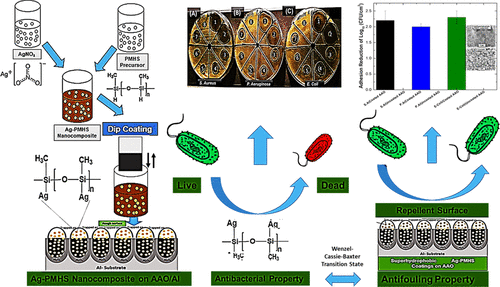当前位置:
X-MOL 学术
›
ACS Appl. Bio Mater.
›
论文详情
Our official English website, www.x-mol.net, welcomes your
feedback! (Note: you will need to create a separate account there.)
Silver–Polymethylhydrosiloxane Nanocomposite Coating on Anodized Aluminum with Superhydrophobic and Antibacterial Properties
ACS Applied Bio Materials ( IF 4.6 ) Pub Date : 2020-06-25 , DOI: 10.1021/acsabm.0c00159 Henry Agbe 1 , Dilip Kumar Sarkar 1 , X-Grant Chen 1 , Nathalie Faucheux 2 , Gervais Soucy 2 , Jean-Luc Bernier 3
ACS Applied Bio Materials ( IF 4.6 ) Pub Date : 2020-06-25 , DOI: 10.1021/acsabm.0c00159 Henry Agbe 1 , Dilip Kumar Sarkar 1 , X-Grant Chen 1 , Nathalie Faucheux 2 , Gervais Soucy 2 , Jean-Luc Bernier 3
Affiliation

|
Biofilm formation on both animate and inanimate surfaces serves as an ideal bacterial reservoir for the spread of nosocomial infections. Designing surfaces with both superhydrophobic and antibacterial properties can help reduce initial bacterial attachment and subsequent biofilm formation. In the present study, a two-step approach is deployed to fabricate silver–polymethylhydrosiloxane (Ag–PMHS) nanocomposites, followed by a simple dip-coating deposition on anodized Al. Ag-nanoparticles (Ag-NPs) are synthesized in situ within a PMHS polymeric matrix. Morphological features of Ag–PMHS coating observed by scanning electron microscopy shows heterogeneous micro–nano-structures. The chemical compositions of these coatings were characterized using X-ray diffraction and attenuated total reflection-Fourier transform infrared spectroscopy, which indicate the presence of a low-energy PMHS polymer. The as-synthesized Ag–PMHS nanocomposite demonstrated excellent antibacterial properties against clinically relevant planktonic bacteria with zone of inhibition values of 25.3 ± 0.5, 24.8 ± 0.5, and 23.3 ± 3.6 mm for Pseudomonas aeruginosa (P.A) (Gram −ve), Escherichia coli (E. coli) (Gram −ve), and Staphylococcus aureus (S.A) (Gram +ve), respectively. The Ag–PMHS nanocomposite coating on anodized Al provides an anti-biofouling property with an adhesion reduction of 99.0, 99.5, and 99.3% for Pseudomomas aeruginosa (P.A), E. coli, and S. aureus (S.A), respectively. Interestingly, the coating maintained a stable contact angle of 158° after 90 days of immersion in saline water (3.5 wt % NaCl, pH 7.4). The Ag–PMHS nanocomposite coating on anodized Al described herein demonstrates excellent antibacterial and anti-biofouling properties owing to its inherent superhydrophobic property.
中文翻译:

具有超疏水和抗菌性能的阳极氧化铝上的银-聚甲基氢硅氧烷纳米复合涂层
有生命和无生命表面上的生物膜形成是医院感染传播的理想细菌库。设计具有超疏水和抗菌特性的表面可以帮助减少最初的细菌附着和随后的生物膜形成。在本研究中,采用两步法制备银-聚甲基氢硅氧烷 (Ag-PMHS) 纳米复合材料,然后在阳极氧化铝上进行简单的浸涂沉积。Ag 纳米颗粒 (Ag-NPs) 在 PMHS 聚合物基质中原位合成。通过扫描电子显微镜观察到的 Ag-PMHS 涂层的形态特征显示出异质的微纳米结构。这些涂层的化学成分使用 X 射线衍射和衰减全反射傅里叶变换红外光谱进行表征,这表明存在低能 PMHS 聚合物。合成后的 Ag-PMHS 纳米复合材料对临床相关的浮游细菌表现出优异的抗菌性能,抑制区为 25.3 ± 0.5、24.8 ± 0.5 和 23.3 ± 3.6 mm铜绿假单胞菌(PA) (Gram -ve)、大肠杆菌(E. coli) (Gram -ve) 和金黄色葡萄球菌(SA) (Gram +ve)。阳极氧化铝上的 Ag-PMHS 纳米复合涂层具有抗生物污损性能,对铜绿假单胞菌(PA)、大肠杆菌和金黄色葡萄球菌(SA) 的附着力分别降低 99.0、99.5 和 99.3%。有趣的是,在盐水(3.5 wt% NaCl,pH 7.4)中浸泡 90 天后,涂层保持 158° 的稳定接触角。本文所述的阳极氧化铝上的 Ag-PMHS 纳米复合涂层由于其固有的超疏水性而表现出优异的抗菌和抗生物污染性能。
更新日期:2020-07-20
中文翻译:

具有超疏水和抗菌性能的阳极氧化铝上的银-聚甲基氢硅氧烷纳米复合涂层
有生命和无生命表面上的生物膜形成是医院感染传播的理想细菌库。设计具有超疏水和抗菌特性的表面可以帮助减少最初的细菌附着和随后的生物膜形成。在本研究中,采用两步法制备银-聚甲基氢硅氧烷 (Ag-PMHS) 纳米复合材料,然后在阳极氧化铝上进行简单的浸涂沉积。Ag 纳米颗粒 (Ag-NPs) 在 PMHS 聚合物基质中原位合成。通过扫描电子显微镜观察到的 Ag-PMHS 涂层的形态特征显示出异质的微纳米结构。这些涂层的化学成分使用 X 射线衍射和衰减全反射傅里叶变换红外光谱进行表征,这表明存在低能 PMHS 聚合物。合成后的 Ag-PMHS 纳米复合材料对临床相关的浮游细菌表现出优异的抗菌性能,抑制区为 25.3 ± 0.5、24.8 ± 0.5 和 23.3 ± 3.6 mm铜绿假单胞菌(PA) (Gram -ve)、大肠杆菌(E. coli) (Gram -ve) 和金黄色葡萄球菌(SA) (Gram +ve)。阳极氧化铝上的 Ag-PMHS 纳米复合涂层具有抗生物污损性能,对铜绿假单胞菌(PA)、大肠杆菌和金黄色葡萄球菌(SA) 的附着力分别降低 99.0、99.5 和 99.3%。有趣的是,在盐水(3.5 wt% NaCl,pH 7.4)中浸泡 90 天后,涂层保持 158° 的稳定接触角。本文所述的阳极氧化铝上的 Ag-PMHS 纳米复合涂层由于其固有的超疏水性而表现出优异的抗菌和抗生物污染性能。











































 京公网安备 11010802027423号
京公网安备 11010802027423号